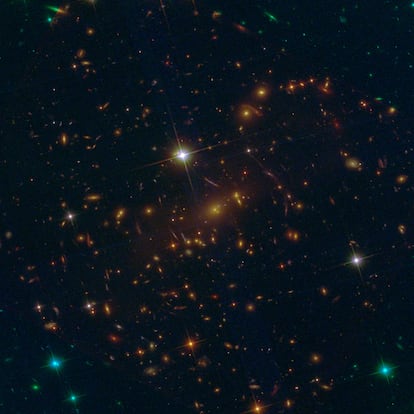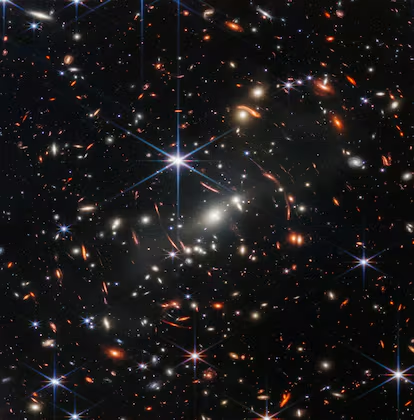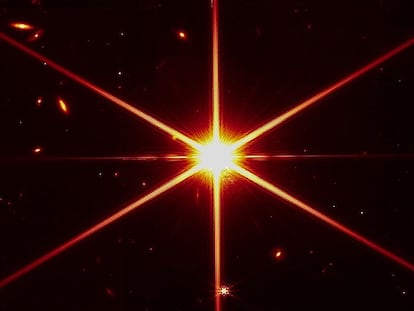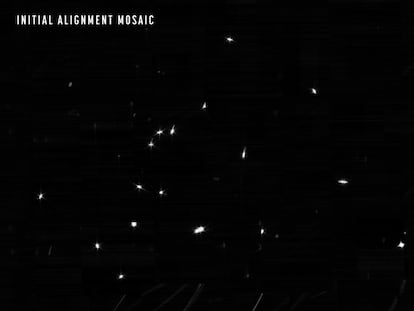James Webb space telescope: A guide to the first full-color image
The photo shows what appears to be thousands of stars, but they are in fact galaxies as they appeared 4.6 billion years ago
US President Joe Biden revealed on Monday the first full-color image taken by the James Webb space telescope, the most powerful telescope ever launched into space. “Today is a historic day,” said Biden, during a ceremony at the White House on Monday evening. “These images are going to remind the world that America can do big things. And they’ll remind the American people, especially our children, that there’s nothing beyond our capacity – nothing beyond our capacity.”
The first images from the space telescope were scheduled to be revealed on Tuesday at 4.30pm (GMT), a time that was agreed upon by the US, European and Canadian agencies involved in the project. But NASA announced unilaterally that Biden would present one of the first images at the Monday press conference.
The image released Monday is the deepest and sharpest infrared image of the distant universe to date, according to NASA. It shows the galaxy cluster SMACS 0723 as it appeared 4.6 billion years ago. The gravitational pull of this cluster warps space and time and acts as a lens that magnifies the light from the more distant galaxies behind it. The image proves that the space telescope is capable of achieving one of its main goals: to see farther into the universe than any other telescope and capture the light from the first stars born after the Big Bang, the explosion that gave birth to the universe 13.7 billion years ago.
“We are looking back more than 13 billion years,” said Bill Nelson, administrator of NASA, at the press conference, adding that the space agency is able to look back around 13.5 billion years.
The image shows thousands of galaxies, including some of the faintest and farthest ones ever observed in the infrared. All of them are contained in a section of the night sky that is equivalent to the size of a grain of sand. This segment belongs to the Sculptor constellation, only visible from the southern hemisphere. The snapshot was taken by Webb’s Near-Infrared Camera (NIRCam), the only one of the four on board the telescope that has been developed entirely by US institutions.
The number of galaxies that appear in the photo is overwhelming. The bright spots in the image are not stars, but rather galaxies made up of billions of stars. What’s more, the photo shows the cluster as it appeared nearly five billion years ago, meaning it is likely that many of the objects no longer exist.
The colors in the image are synthetic. Telescopes record images in black and white, through colored filters. Combining several shots of the same field obtained at different wavelengths, it is possible to show what they would have looked like to the human eye, although the color palette will always be, to some degree, artificial, since much of the light in the infrared is invisible. In the case of the first image from the James Webb, six filters have been used: two in different shades of blue, two in green and two in red.


To collect enough light, the space telescope’s mirror had to remain pointed at the same region of the sky for more than 12 hours. By way of comparison, the Hubble space telescope needed more than 200 hours, over many sessions and several months.
The James Webb telescope is one of the largest scientific projects in history, both in scale and cost – $10 billion. It also took three decades to design, build and launch.
At the moment, the observatory is orbiting around the Sun at the second Lagrange Point, 1.5 million kilometers from Earth. The observatory is specialized in capturing infrared light – invisible to human eyes – which is emitted by distant objects. What’s more, it is the first space telescope that can see through dust clouds and capture the stars behind them. Thanks to the James Webb and other existing space telescopes, such as Hubble and Chandra, scientists will be able to observe the cosmos in unprecedented detail.
The release of the image is a preview of a series of high-resolution color pictures from the James Webb that will be released by NASA on Tuesday at 4.30pm (GMT).
The images from the space telescope are set to show the following:
The Carina Nebula. Located 7,600 light-years from Earth, it is the brightest known nebula.
WASP-96b. This giant planet – somewhat larger than Jupiter – is 1,150 light-years away from Earth. If a year on Earth is 365 days, the time it takes for the planet to complete an orbit around the Sun, WASP-96b is so close to its sun that each year lasts just three and a half days.
NGC 3132. This huge, expanding cloud of gas surrounds a dying star 2,000 light-years from Earth. It is also known as the Southern Ring Nebula, and is only visible from the southern hemisphere.
Stephan’s Quintet. This is the first compact galaxy group ever discovered. Stephan’s Quintent was discovered in 1877 by the French astronomer Édouard Jean-Marie Stephan. The group is about 300 million light-years away from Earth.
SMACS 0723. The force of gravity exerted around a nearby galaxy can work like a magnifying glass, amplifying the light of much more distant galaxies behind it. The James Webb will capture this phenomenon to show that these astronomical lenses can be used to study very distant objects.
Tu suscripción se está usando en otro dispositivo
¿Quieres añadir otro usuario a tu suscripción?
Si continúas leyendo en este dispositivo, no se podrá leer en el otro.
FlechaTu suscripción se está usando en otro dispositivo y solo puedes acceder a EL PAÍS desde un dispositivo a la vez.
Si quieres compartir tu cuenta, cambia tu suscripción a la modalidad Premium, así podrás añadir otro usuario. Cada uno accederá con su propia cuenta de email, lo que os permitirá personalizar vuestra experiencia en EL PAÍS.
¿Tienes una suscripción de empresa? Accede aquí para contratar más cuentas.
En el caso de no saber quién está usando tu cuenta, te recomendamos cambiar tu contraseña aquí.
Si decides continuar compartiendo tu cuenta, este mensaje se mostrará en tu dispositivo y en el de la otra persona que está usando tu cuenta de forma indefinida, afectando a tu experiencia de lectura. Puedes consultar aquí los términos y condiciones de la suscripción digital.











































